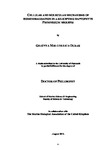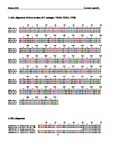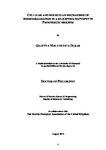CELLULAR AND MOLECULAR MECHANISMS OF BIOMINERALISATION IN A SILICIFYING HAPTOPHYTE PRYMNESIUM NEOLEPIS
| dc.contributor.supervisor | Brownlee, Colin | |
| dc.contributor.author | Durak, Grazyna | |
| dc.contributor.other | School of Biological and Marine Sciences | en_US |
| dc.date.accessioned | 2014-09-08T14:13:59Z | |
| dc.date.available | 2014-09-08T14:13:59Z | |
| dc.date.issued | 2014 | |
| dc.date.issued | 2014 | |
| dc.identifier | 10085641 | en_US |
| dc.identifier.uri | http://hdl.handle.net/10026.1/3098 | |
| dc.description | Full version unavailable due to 3rd party copyright restrictions. | |
| dc.description.abstract |
Haptophytes are renowned for the most prominent and biogeochemically important group of marine calcifiers: coccolithophores. The unexpected discovery of a unique, silicifying member of this clade - Prymnesium neolepis - prompted questions regarding mechanisms of silicification and their origin in the calcifier-dominated haptophytes. To address these questions I used cell physiology, biochemistry and molecular approaches, investigating cellular and molecular mechanisms involved in silicification in haptophytes. Comparisons of this system with calcification in coccolithophores and other silica-based systems in eukaryotes were also made. Here I report that P. neolepis is an obligate silicifier, producing silica scales in a process fundamentally different to that observed in coccolithophores. Scale deposition and secretion in P. neolepis is localized in the posterior, vacuolar part of the cell rather than in the anterior part near the flagellar roots as in calcifying coccolithophores. The organic matrix underlying silica scales in P. neolepis was found to be non-homologous with organic scales, which in coccolithophores serve as coccolith baseplates. This suggests, that silica scales and coccoliths arise from two distinct, most likely non-homologous processes, which is further supported by the comparative investigation of the role of cytoskeleton in silica scale production in P. neolepis and coccolithogenesis in a representative calcifier, Coccolithus pelagicus. Using cytoskeleton inhibitors I established, that the cytoskeleton components used for morphogenesis and secretion of biomineralised structures are different in these two systems. Analysis of P. neolepis biosilica revealed the presence of an intimately associated organic fraction consisting of a putatively chitin-containing material, potentially serving as an organic matrix underlying silica scales. Further biochemical investigation of the biosilica-associated organics confirmed the presence of long chain polyamines (LCPAs) dissimilar to those previously reported in diatoms and sponges. Additionally, a potentially novel, proline and lysine-rich protein sharing a weak homology with lipocalins was recovered, suggesting that this silicification system is unique to haptophytes. Several theories concerning acquisition of the ability to silicify in haptophytes were proposed. Overall, the findings presented in this study provide a detailed description of Si biomineralisation system in this unique, silicifying haptophyte and supply novel information on biomineralisation systems in marine haptophytes. This study contributes a basis on which the phenomenon of silicification in haptophytes can be further investigated, as well as novel information which can be further used in elucidation of origins of silicification in algae and other Eucarya. | en_US |
| dc.description.sponsorship | EU Interreg IV Marinexus Project | en_US |
| dc.language.iso | en | en_US |
| dc.publisher | Plymouth University | en_US |
| dc.subject | algae, biomineralization | en_US |
| dc.title | CELLULAR AND MOLECULAR MECHANISMS OF BIOMINERALISATION IN A SILICIFYING HAPTOPHYTE PRYMNESIUM NEOLEPIS | en_US |
| dc.type | Thesis | |
| plymouth.version | Edited version | en_US |
| dc.identifier.doi | http://dx.doi.org/10.24382/3274 |
Files in this item
This item appears in the following Collection(s)
-
01 Research Theses Main Collection
Research Theses Main




